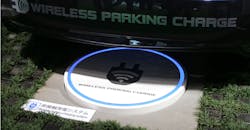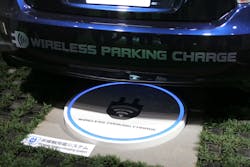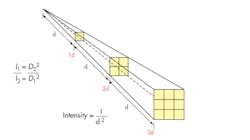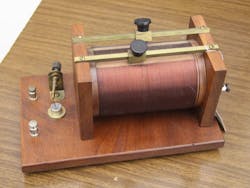Most people associate the name Tesla with the company that helped popularize electric cars. You may also know that the company is named after Nikola Tesla. However, the groundbreaking serial innovator wasn’t necessarily thinking of cars when he invented his AC motor. He wanted to propel humanity to a future where everyone could focus more of their time on what brought them joy rather than needing to work. One way he thought this could be accomplished was through free wireless power.
Wireless Charging
Today we have wireless power through induction. Often used to charge phones and small electronics, induction technology requires contact with a charging surface or is limited to about an inch-and-a-half. With the growth of electric cars, some companies have designed charging stations that could charge cars over a short distance. these would enable a car to simply park over a space and instantly charge. Charging lanes could also become a reality: A car could enter a specially designed lane that would charge it while in motion.
If every time an electric vehicle was parked it could wireless charge, daily driving wouldn’t require the inconvenience of plugging in or stopping at a charging station. (Credit: By NJo [CC BY-SA 3.0], from Wikimedia Commons)
About two years ago, Oak Ridge National Laboratory researchers testing wireless options were able to transmit 20 kW to a passenger vehicle at about 90 to 95% efficiency. This wireless efficiency is competitive with plug-in or wire chargers at about 94%. For example, the Advanced Power Electronics Lab (APEL) at Kettering University collaborated with HELLA, an automotive electronics company, to develop a compact vehicle charger with an efficiency of 97%, more than 3% more than the average for these plug-in chargers. In addition, wireless charging eliminates the cost of wires and problems with connectors.
Induction charging has regulations such as the FCC Part 15, a different set of rules called Part 18, and standards developed by the Wireless Power Consortium called Qi (pronounced like CHEE). While these regulations and standards may talk about charging rates or improved thermal test for transmitters, physics still governs the distance an object can charge. With induction, the farther an object is from the power source, the slower it charges.
Mobile Power
Far field wireless power had been a dream of Nikola Tesla, and researchers are still working on improving this technology today. Mobility has been an ever-growing trend. Today, with the Industrial Internet of Things (IIoT), wearables mobility is continuing to grow. But as mobile power needs increase, battery technology is not keeping up.
Consider the cost of disposable batteries. The current kWh taken from the grid is about $.12, while alkaline batteries range from $68 to $406. Nickel-based and lead-acid batteries get closer at about $20 to $8 per kWh. Even with the extra charging power of a lithium batteries, the premium cost can still get about $1 to $4 per kWh, according to BatteryUniversity.com.
It isn’t just the cost of batteries that can cause problems, but also the weight associated with them. Mobile applications often are concerned with weight, so having an option to power mobile objects without a battery can free designers and users from the batteries’ cost and weight.
IIoT is driving for more sensors and computing on the Edge, which has increased the demand for remote power. Even if the battery can last a long time, eventually it will need to be replaced. Often, remote or Edge devices are not quick or easy to access, which leads to long replacement times. As devices in a system grow, replacing batteries could start to consume more and more labor.
The Problem with Distance and Physics
In attempting to increase power at a distance, electromagnetic waves seem to travel better than electromagnetic fields. Unfortunately, radio waves have distance limitation too. Newton’s inverse-square law (intensity is inversely proportional to the square of the distance from a source) in short states that the farther you get from the power source, the weaker the charge:
I1/I2 = D22/D12
Where D1 and D2 are the distance 1 and 2 form the source, respectively. I1 is the intensity 1 at D1, and I2 is the intensity 2 at D2.
This law can be used to calculate the intensity of radio waves and explain why it would be difficult to power a large laptop or TV from across a room. (Image Credit: NDR)
Part 15 from the FCC limits the amount of power output from an RF transmitter to one watt. With this power limitation, and the decrease in power over distance, it is no surprise that many companies are using the FCC’s Part 18 to circumnavigate this power restriction.
While there is a lot to these regulations it seems 15 has lower power as it relates to communication. However, if the device is strictly for charging and meets other stipulations, such as exposure to people, Part 18 let’s higher powers be transferred. Unfortunately, this regulation doesn’t circumnavigate physics.
There are companies working on this, but some of them even claim that if a device was transmitting 10 W, a device charging at 6 ft will only give you 1 W. Following this inverse square law with these numbers by about 13 ft you wouldn’t transmit enough to charge a smartphone (if turned on). However, at about .2 W, it would slow the batteries’ depletion.
A New Digital Factory
While .2 W doesn’t sound like much, it could be enough to power sensors. Small wireless sensors don’t require the energy of a smartphone or vehicle. Being able to place sensor that can send data via Wi-Fi and be powered wirelessly eliminates dozens of tiny batteries or wires from a system.
While current technology might not sound great for an industrial manufacturing setting, consider stress strain gages. Some aerospace and automotive applications might place dozens of stress strain gages on a chassis or wing. Wiring each takes many hours. Being able to place a stress strain gage in position without the added weight of a battery that might interfere with testing, with a lightweight sensor powered and communicating wirelessly, would save time.
Some companies are already shipping wireless transmitters. Powercast sells the TX91503 RF wireless transmitter, a 6 ft power cord, a USB wall outlet adapter, and a quick start guide for $100. The company claims it is the industry’s first to work in far field applications (up to 80 ft), but it’s only transmitting 3 W. If this device follows the example previously mentioned and the inverse-squared formula, there would be virtually no usable power past 6 ft. However, this would be great if you have a lot of wireless devices around your desk: game controllers, headphones, keyboards, mice, etc.
Also, it uses Bluetooth to recognize the device or devices. One might argue that Bluetooth only goes to 33 ft, but that is for Class 2 Bluetooth. There are other classes that operate in longer ranges, and there are techniques that could extend the range of Bluetooth to accomplish the 80 ft far field claim. The question is how much power this device can deliver at 80 ft.
Power Harvesting
Wireless power is nothing new; crystal radios were the first widely used energy harvesters. They were also the most common radios used during the wireless telegraphy era, circa 1904. Inexpensive and reliable, they were a driving force in introducing radio to the public and contributed to the development of radio broadcast entertainment back in the 1920s.
A passive receivers the crystal radio receiver requires no power sources. It uses the power of incoming radio waves received by a wire antenna.
Today’s devices need more wireless power than a crystal radio can harvest, but it is a proof of concept. Transducers are getting more advanced, electronics are using less and less energy, the IoT is driving devices closer to the Edge, electronic costs are coming down faster than batteries, IoT infrastructure supports device on the Edge, devices are only as reliable as their power sources, and IoT is causing a rethinking of system architectures, which is fueling the idea of power harvesting.
The military will often carry thin film for its weight-to-output ratio. However, in the case of explosions, shrapnel, or being shot, this panel can continue to generate power.
As electronics become more mobile, and the IIoT drives Edge computing power harvesting technology is work with batteries to extend the time until they need to be replaced. There is a lot of research happening with microthermal and vibration harvesting devices, but currently piezoelectric and photovoltaic technology seem to be on the leading edge.
For factory and mobile applications new photovoltaic films are popular. Mono and polycrystalline panels might deliver more power, but they operate on a narrower bandwidth. Without direct light from the sun mono and polycrystalline panels can be inefficient. If you need power inside the wider bandwidth of film may work better.
Also, film is less susceptible to shading. Mono and polycrystalline panels are wired in series. If a section of the panel is shaded the entire row or panel section might stop charging. There are workarounds, but films are robust, have a wider bandwidth they can generate electricity with, and are lighter for mobile applications. “A 30-W silicon panel [c-Si] weighs 7 lb and a 30-W foldable [CIGS] from P3 solar weighs 0.75 lb,” explains Amy Beaudet, an application engineer for altE solar company. “That's a big difference if you are hiking with it.” This aspect has led some mobile and remote applications, such as outdoor enthusiasts or military personnel, to use thin-film technology.
For manufacturing IIoT and Edge computing power, focusing on vibration and indoor lights is convenient. Normally if you are up and running, there are lights on or vibration coming from somewhere. This could eliminate the need for a battery. While photovoltaics don’t need to be replaced and could arguably produce power indefinitely (while everything has a lifespan, some of the original crystalline panels are still working), the initial capital is still giving batteries the lower barrier of entry. In addition, the DC power from a battery can flow easily to an electronic where the AC current from a photovoltaic will require additional electronics to mitigate the flow of electricity.
Batteries aren’t perfect, but for now, they are an easy solution for mobile or remote power. If solar can increase its return on investment, or wireless can more effectively charge at greater distances, the battery industry might see a change. However, with the speed of technology, the convenience of designing with batteries, and the size and growth in mobile/remote power market, it is more likely that the application will select the solution. For now, Tesla’s dream of long-distance free power will continue to be haunted by Newton’s physics.





